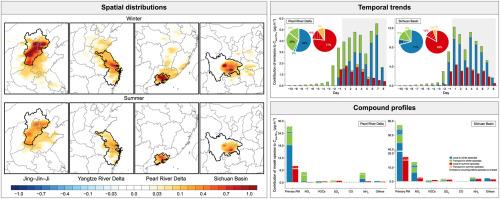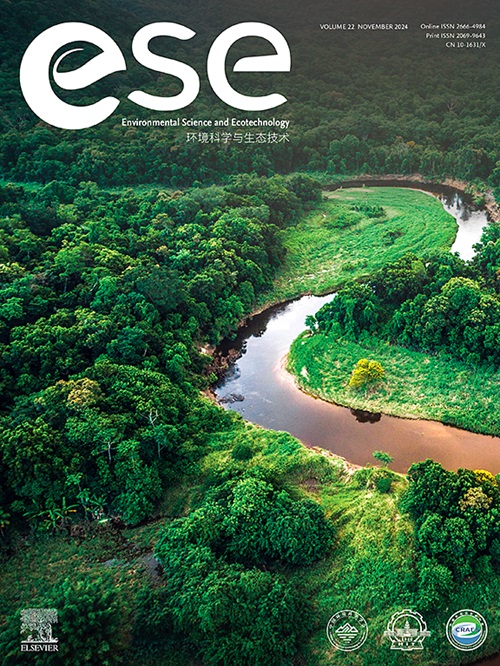Adjoint analysis of PM2.5 and O3 episodes in priority control zones in China
IF 14.3
1区 环境科学与生态学
Q1 ENVIRONMENTAL SCIENCES
引用次数: 0
Abstract
Understanding and mitigating PM2.5 and ozone (O3) pollution remains challenging due to the nonlinear atmospheric chemistry and spatially heterogeneous nature of pollutant emissions. Traditional forward modeling approaches suffer from high computational cost and limited diagnostic resolution to precisely attribute emissions sources at fine spatial, temporal, and chemical scales. Adjoint modeling has emerged as an efficient alternative, enabling high-resolution, multi-pollutant source attribution in a single integrated framework; however, its application to simultaneous PM2.5–O3 pollution episodes is limited, particularly in densely populated regions experiencing complex co-pollutant interactions. Here we apply a newly developed multiphase adjoint of the Community Multiscale Air Quality (CMAQ) model to quantify the emission sensitivities of PM2.5 and O3 concentrations during pollution episodes in major urban agglomerations. Our results indicate that local emissions predominantly drive PM2.5 concentrations, contributing up to 79 μg m−3. In contrast, O3 episodes are largely initiated by regional transport (3.8–7.3 ppbv), surpassing local emission contributions during episode onset. The sensitivity analyses reveal distinct spatial emission signatures and pollutant-specific influences from critical precursors, including volatile organic compounds (VOCs; up to 15.9 ppbv O3, 11.4 μg m−3 PM2.5), nitrogen oxides (NOx; 16.6 ppbv O3, 13.8 μg m−3 PM2.5), and ammonia (NH3; up to 8.7 μg m−3 PM2.5). This study demonstrates the diagnostic strength and predictive capabilities of adjoint modeling in unraveling complex source–receptor relationships. By offering detailed, pollutant-specific emission sensitivity information, our approach provides a robust foundation for precision-driven emission control strategies and improved cross-regional policy coordination, substantially advancing air quality management frameworks.

中国重点控制区PM2.5和O3的伴随分析
由于大气化学的非线性和污染物排放的空间异质性,理解和缓解PM2.5和臭氧污染仍然具有挑战性。传统的正演模拟方法存在计算成本高和诊断分辨率有限的问题,无法在精细的空间、时间和化学尺度上精确地确定排放源的属性。伴随建模已成为一种有效的替代方法,可在单一集成框架中实现高分辨率、多污染源归属;然而,它在同时发生的PM2.5-O3污染事件中的应用是有限的,特别是在经历复杂的共污染物相互作用的人口稠密地区。本文采用一种新开发的社区多尺度空气质量(CMAQ)模型的多相伴随模型,量化了主要城市群污染期间PM2.5和O3浓度的排放敏感性。我们的研究结果表明,当地排放主要驱动PM2.5浓度,贡献高达79 μg m - 3。相比之下,O3发作主要是由区域运输引起的(3.8-7.3 ppbv),超过了发作时当地排放的贡献。敏感性分析揭示了不同的空间排放特征和关键前体污染物的特定影响,包括挥发性有机化合物(VOCs);高达15.9 ppbv O3, 11.4 μg m−3 PM2.5),氮氧化物(NOx;16.6 ppbv O3, 13.8 μg m−3 PM2.5)和氨(NH3;高达8.7 μg m−3 PM2.5)。本研究证明了伴随模型在揭示复杂的源-受体关系方面的诊断强度和预测能力。通过提供详细的特定污染物排放敏感性信息,我们的方法为精确驱动的排放控制策略和改进的跨区域政策协调提供了坚实的基础,大大推进了空气质量管理框架。
本文章由计算机程序翻译,如有差异,请以英文原文为准。
求助全文
约1分钟内获得全文
求助全文
来源期刊

Environmental Science and Ecotechnology
Multiple-
CiteScore
20.40
自引率
6.30%
发文量
11
审稿时长
18 days
期刊介绍:
Environmental Science & Ecotechnology (ESE) is an international, open-access journal publishing original research in environmental science, engineering, ecotechnology, and related fields. Authors publishing in ESE can immediately, permanently, and freely share their work. They have license options and retain copyright. Published by Elsevier, ESE is co-organized by the Chinese Society for Environmental Sciences, Harbin Institute of Technology, and the Chinese Research Academy of Environmental Sciences, under the supervision of the China Association for Science and Technology.
 求助内容:
求助内容: 应助结果提醒方式:
应助结果提醒方式:


